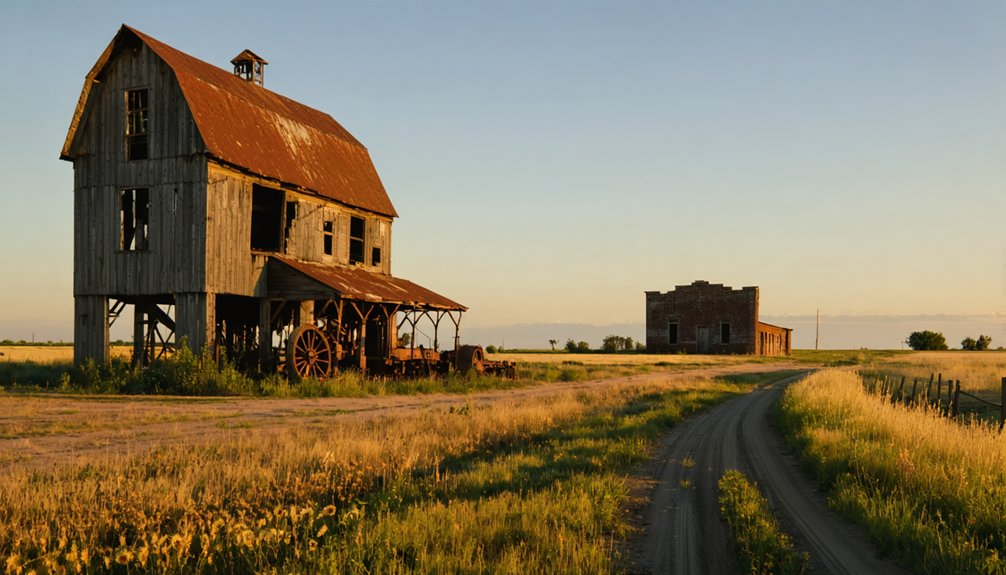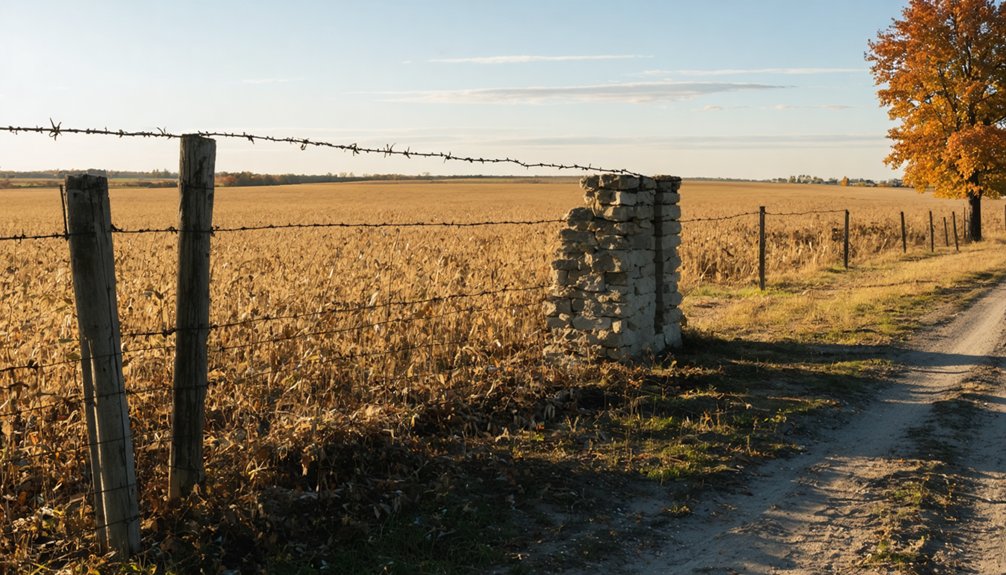You’ll find Evans, Illinois, in Marshall County between the Illinois and Wabash Rivers. This former railroad settlement thrived in the late 1800s as an essential transportation hub along the Chicago & Alton Railroad, featuring a post office, general store, and blacksmith shop. The town’s decline began with rural postal delivery in 1905, and today only scattered remnants mark its location. Its story mirrors countless other Midwestern communities that rose and fell with the railroads.
Key Takeaways
- Evans was a small frontier settlement in Marshall County, Illinois that developed around the Chicago & Alton Railroad station.
- The town served as an agricultural hub with essential services including a general store, blacksmith shop, and post office.
- The community’s decline began in 1905 with rural postal delivery implementation, leading to post office closure after 32 years.
- Evans’ dependence on railroad activities and failure to diversify its economy ultimately led to its complete abandonment.
- Today, only scattered remnants remain, including old railroad grades, weathered bridge abutments, and building foundations in the soil.
Early Settlement Origins
While the Black Hawk War shaped much of Illinois’ early settlement patterns, Evans emerged as a small frontier community in Marshall County near strategic railroad routes.
In this untamed landscape, you’d find settlers drawn by the promise of fertile soil and abundant natural resources, particularly timber and water sources essential for survival. Early community growth mirrored the state’s explosive expansion from 2,458 residents in 1800.
Settler motivations centered on establishing productive farmland, with many families choosing Evans for its rich soil and defensive positioning. Like many lost towns and villages that once dotted Illinois, Evans represented the pioneering spirit of early settlement.
Early settlers were drawn to Evans primarily for its agricultural potential, combining fertile land with naturally defensible terrain.
You’ll understand their agricultural practices evolved from necessity – they cleared land, built basic shelters, and planted wheat and other crops suited to Illinois’ climate.
The community grew steadily as pioneering families constructed fortified structures, providing safety during uncertain times while fostering the development of essential services like blacksmithing and basic trade networks.
Railroad’s Role in Town Development
After the Chicago & Alton Railroad established a station at Evans in the late 1800s, you’d find the town emerging at a strategic junction where two major rail lines intersected.
The Illinois Central Railroad crossed the Chicago & Alton at this remote prairie location, transforming an empty landscape into a bustling transportation hub. Like the Illinois Traction System, the station played a vital role in connecting rural communities to larger cities.
You’d see the town’s infrastructure develop around the railroad’s needs, with a general store and blacksmith shop serving rail operations.
Evans quickly became a crucial shipping point for local farmers, who relied on the station to transport their grain and livestock. The station’s position at the highest point between the Illinois and Wabash Rivers made it an ideal location for shipping.
However, this agricultural reliance proved precarious. When rural postal delivery arrived in 1905, it triggered an economic decline.
The town never expanded beyond its basic rail-serving functions, and without diversification, Evans gradually faded into obscurity.
Geographic Features and Location
Today, you’ll find Evans as an unincorporated community nestled in the heart of Logan County, Illinois, about 5 miles north of Lincoln. You won’t find many notable geographic landmarks here – the landscape stretches across the characteristically flat Illinois prairie, where fields of corn and soybeans dominate the horizon.
The area’s agricultural practices reflect the region’s rich farming heritage, taking advantage of the fertile Midwestern soil. While you won’t encounter any significant water features or dramatic elevation changes, you’ll experience the typical continental climate that shapes life here – humid summers, pleasant falls, and cold winters. Like many locations with the name Evans in place names, this community reflects the widespread use of this common identifier across America.
Similar to many lost towns documented in Illinois history, Evans has seen significant changes over time. The community sits at coordinates 40°13′18″N 89°21′50″W, surrounded by other historic towns like Atlanta and Mount Pulaski, making it a reflection of central Illinois’ rural character.
Community Life and Infrastructure
During its heyday in the late 1800s, Evans served as a bustling agricultural hub centered around its Chicago & Alton railroad station. The town’s agricultural economy thrived through its indispensable community services, supporting local farmers and merchants alike. Much like nearby ghost town Cardiff, Evans experienced economic hardship that led to its eventual abandonment.
Evans flourished as a vital agricultural center in the 1800s, its railroad station and services forming the backbone of local commerce.
Similar to how the Port of Chicago revolutionized Illinois commerce, Evans became an important transportation nexus for the region.
You’ll find that Evans offered four key pillars of commerce and connectivity:
- A general store stocking essential supplies for area residents
- A blacksmith shop maintaining critical farm equipment
- A post office (1873-1905) linking the community to the outside world
- A railroad station facilitating grain and livestock shipping
Despite its strategic location as the highest point between the Illinois and Wabash Rivers, Evans never grew into a significant residential settlement.
The advent of Rural Free Delivery and declining railroad importance eventually led to the town’s fade into obscurity.
Transportation Hub Along Chicago & Alton
If you’d visited Evans during its heyday, you’d have found the Chicago & Alton’s double-track mainline cutting through the highest elevation between the Illinois and Wabash Rivers.
The station served as a crucial agricultural shipping point, where local farmers brought their grain and livestock for transport to major markets like Chicago and St. Louis. After 1875, the area also connected to Coal City via the Chicago & Illinois River railroad.
The railroad grade through Evans supported both freight loading operations and regional rail traffic, though the station’s facilities remained modest compared to larger towns along the line. By 1859, passengers could enjoy the comfort of first sleeping cars designed by George Pullman and built in the railroad’s Bloomington shops.
Railroad Grade Development
Three major railroad developments shaped Evans, Illinois into an important transportation hub along the Chicago & Eastern Illinois Railroad network.
As part of the C&EI system’s expansion, you’ll find the railroad grade’s evolution directly impacted regional transportation technology and economic implications throughout Illinois and Indiana.
- The 1853 completion of the Evansville and Illinois Railroad connection established Evans’ initial rail infrastructure.
- Strategic positioning near Danville’s locomotive repair shops enhanced maintenance capabilities by 1877.
- The 1911 C&EI consolidation streamlined operations through Evans.
- The Momence interchange created crucial links to the Chicago and Indiana Coal Railroad.
Evans’ railroad grade development fostered economic growth through improved freight movement, passenger service, and employment opportunities, while connecting rural communities to major Midwest markets.
Freight Loading Operations
Evans’ bustling freight operations centered around an extensive loading complex that served as an integral transportation hub along the Chicago & Alton Railway.
You’d find loading docks handling everything from wheat to livestock, with specialized freight cars designed for ideal cargo management. The hub’s strategic position made it essential for connecting rural producers with Chicago’s urban markets.
The facility’s freight efficiency relied on well-coordinated track configurations, including multiple sidings and passing loops that kept traffic flowing smoothly.
You could spot dedicated automobile cars, introduced in the 1920s, moving alongside traditional cargo. The hub’s integration with warehouse facilities and connection to multiple branch lines made it a critical link in the region’s transportation network, processing billions of revenue ton-miles during its peak operations.
Station Stop Importance
While freight operations drove much of the activity at Evans station, its role as a passenger stop along the Chicago & Alton Railroad marked a key point between the Illinois and Wabash Rivers.
The station’s significance stemmed from its strategic position at Evans Point, the highest elevation in the area.
You’ll appreciate these key aspects of Evans’ rail connectivity:
- The station served as a junction where the C&A mainline crossed the Illinois Central Railroad.
- It provided essential passenger services during the late 1800s along the Chicago-St. Louis corridor.
- A post office operated from 1873 to 1905, making it a crucial communication hub.
- The location offered travelers a necessary rest stop in otherwise open prairie terrain.
Despite its isolation, Evans maintained its role as a critical transportation link until changing railroad patterns led to its decline.
Decline and Abandonment

Despite its promising start as a railroad station and shipping hub, Evans began a steady decline in the late 19th century that would eventually lead to its complete abandonment. The town’s economic vulnerability became apparent as it failed to diversify beyond its railroad-dependent activities, while its rural isolation limited opportunities for growth and development.
You can trace Evans’s downfall through several key events. The post office’s closure in 1905 marked a significant turning point, as Rural Free Delivery made local postal services obsolete.
The town’s dependence on the Chicago & Alton Railroad proved fatal when changing transportation patterns favored larger regional hubs. Without substantial infrastructure or natural resources to sustain it, Evans gradually faded away.
Today, nothing remains of this prairie settlement – the land has returned to agricultural use, leaving only historical records to tell its story.
Notable Landmarks and Structures
If you’re exploring Evans today, you’ll find the most prominent remnant is the old railroad grade, which cuts through the landscape as a lasting symbol of the town’s railway heritage.
The foundations of several historical buildings, including what’s believed to be the former post office, can still be traced in the soil near where the main streets once intersected.
The town’s strategic location at a community crossroads, where local roads met the railroad line, made it an important transportation hub in Marshall County’s early development.
Railroad Grade Remnants
The abandoned Chicago & Alton Railroad grade through Evans remains partially visible today, with several sections surviving as dirt paths and raised embankments characteristic of historic Southern Illinois rail lines.
For railroad archaeology enthusiasts exploring these historic pathways, you’ll find evidence of the region’s rail heritage through artifact recovery and structural remains.
Key features you can still discover along the grade include:
- Weathered stone and concrete bridge abutments marking former crossing points
- Scattered metal spikes and track fasteners hidden beneath vegetation
- Depression marks at old grade crossing sites where railways intersected
- Original earthwork contours where the rail bed was elevated through prairie terrain
These physical remnants serve as lasting indicators of Evans’ role in the area’s once-bustling rail network, though much has returned to farmland.
Historical Building Foundations
Beyond the railroad remnants, scattered building foundations across Evans offer compelling insights into the town’s architectural evolution.
You’ll find evidence of log cabin settlements marked by low stone bases and dirt depressions, while more substantial brick and stone foundations reveal the town’s shift to permanent structures. Foundation materials range from early timber supports to later limestone and concrete mixtures, reflecting the changing availability of local resources.
Throughout Evans, you can trace the footprints of various structures – from the sturdy bases of commercial buildings and stores to the remnants of residential foundations that once supported multistory homes.
While many of these historical foundations now lie hidden beneath vegetation, their preservation techniques have left lasting imprints of the community’s former energy.
Community Crossroads Location
Situated at critical railroad crossroads in Marshall County, Evans once served as an essential transportation hub linking several neighboring ghost towns including Custer, Porterfield, and Garfield.
You’ll find this historic site nestled in rural Illinois landscapes, accessible via two-wheel drive roads near the town of Varna.
Evans’s community significance centered around its strategic transportation connectivity, highlighted by these key features:
- A post office operated from 1873 to 1905, marking Evans as a crucial communication center
- Multiple railroad crossings connected Evans to regional freight and passenger routes
- The old railroad grade served as the town’s lifeline to surrounding communities
- Porterfield station facilitated goods and passenger movement along the line
While nothing visibly remains today, Evans’s location at these historic crossroads shaped its brief but impactful existence.
Marshall County Historical Context
Originally part of Putnam County, Marshall County emerged as an independent entity on January 19, 1839, during a period of rapid settlement and growth in north-central Illinois.
You’ll find that settlement patterns began with Thomas Brooks’ brief stay in 1824, followed by John Strawn‘s permanent establishment near Lacon in 1828. Early agriculture took root as pioneers set up the first grinding mill in Hopewell township by 1830.
As you explore the county’s beginnings, you’ll discover how settlements spread across Round Prairie and along waterways, with communities like “Robert’s Point” and “Strawn’s Woods” emerging by 1829.
The county’s population reached 1,500 by its formation, with Lacon serving as the county seat. Named after Chief Justice John Marshall, the area quickly developed into a thriving agricultural region.
Legacy in Local Memory

You’ll find Evans’ brief life as a railroad town reflects common settlement patterns throughout Illinois, where communities rose and fell with their rail connections.
The town’s story as a grain and livestock shipping point remains preserved in local folklore, particularly through memories of Evans Point and its strategic location on the Chicago & Alton line.
While no physical structures survive today, the community’s memory lives on through historical records and oral histories passed down by Marshall County residents who remember its once-bustling role in regional commerce.
Railroad Town’s Brief Life
While little physical evidence remains of Evans today, the town’s legacy lives on in local memory as a quintessential Illinois railroad settlement. This ghost town‘s brief but significant history centers on its strategic location where the Chicago & Alton and Illinois Central railroads intersected in Marshall County.
During its peak, Evans served several crucial functions:
- Primary shipping point for local grain and livestock
- Home to essential businesses like a general store and blacksmith shop
- Post office hub from 1873 until 1905
- Highest elevation point between Illinois and Wabash Rivers
You’ll find Evans’ story mirrors many similar railroad towns that flourished briefly but couldn’t sustain growth beyond their initial purpose.
When Rural Free Delivery arrived in 1905, the town gradually faded into history, leaving only stories of its railroad heritage.
Regional Settlement Patterns
The story of Evans represents a common pattern in Illinois’ railroad settlement history. You’ll find numerous ghost towns across the prairie that share Evans’ trajectory – places that sprouted up at rail junctions with high hopes but couldn’t sustain lasting communities.
These settlement patterns reveal how railroad accessibility alone wasn’t enough to guarantee permanence.
Evans exemplifies the ghost town dynamics that played out repeatedly in 19th century Illinois. While the railroads promised prosperity, towns needed more than just shipping points to thrive.
Without schools, churches, or a stable residential population, Evans faded into obscurity. Today, you won’t find any physical traces of the town, but its story lives on as a reflection of the fleeting nature of rail-dependent settlements in America’s heartland.
Community Memory Preservation
Despite lacking physical remnants, Evans’s legacy persists through a patchwork of informal community memory channels. You’ll find the town’s story preserved primarily through community storytelling, with local post office staff and railroad enthusiasts serving as unofficial custodians of its history.
Memory preservation efforts continue through:
- Oral histories shared by residents of nearby Wenona and Varna
- Online forums where enthusiasts exchange historical fragments
- Digital archives maintained by Illinois history journals
- Personal accounts passed down through generations of railroad workers
While Evans’s claim as the highest point between the Illinois and Wabash Rivers endures in local lore, you’ll discover that most details of daily life in this former railroad town survive only through scattered records and anecdotal evidence.
Present-Day Site Conditions
Modern visitors to Evans will find little evidence of the former railroad town that once stood in Marshall County, Illinois. The old railroad grade where this ghost town once thrived is now reclaimed by nature, with overgrown vegetation obscuring any traces of its past.
Time has erased Evans from the Illinois landscape, leaving only whispers of its railroad legacy beneath wild overgrowth.
You’ll need to time your ghost town exploration carefully, as severe weather and difficult terrain can make the site challenging to access. The best months to visit are between May and October.
While Evans held historical significance as a rail transport hub with a post office operating until 1905, today you’ll encounter only rural landscapes of farmland and forest.
The 2WD-accessible roads that lead to the former town site offer limited infrastructure, and without maintained trails or markers, you’re fundamentally searching for shadows of the past.
Frequently Asked Questions
Were There Any Significant Mining or Agricultural Activities in Evans?
While Evans had a 32-year post office run, you won’t find concrete evidence of mining history there. Though surrounded by farmland, there’s no proof of significant agricultural practices within the town itself.
Did Any Famous Travelers or Personalities Ever Pass Through Evans?
You won’t find records of any famous visitors or historical figures passing through this location. It was primarily a functional rail station for shipping grain and livestock, not a destination for notable personalities.
What Was the Average Property Value in Evans During Its Peak?
You’d love to know the exact property price trends, but historical economic factors have left us with no surviving records of average values during Evans’ railroad-driven peak.
Were There Any Native American Settlements Near Evans Before Its Establishment?
You’ll find that Native tribes like the Kickapoo and Potawatomi established settlements in the region before Evans. Archaeological evidence shows they lived along nearby rivers, maintaining seasonal camps and villages.
Did Evans Have Any Sister Towns or Rival Communities Nearby?
While you might think Evans stood alone, it actually had several sister towns nearby, including Varna, Custer, Porterfield, and Garfield. These rival communities competed along the railroad lines.
References
- http://cantontornado36.blogspot.com/2017/04/ghost-towns-of-fulton-county-illinois.html
- https://history.weld.gov/County-150/Weld-County-Towns/Ghost-Towns-in-Weld-County
- https://drloihjournal.blogspot.com/2022/09/lost-towns-of-illinois-evans-illinois.html
- https://drloihjournal.blogspot.com/p/lost-towns-of-illinois-series.html
- https://freepages.rootsweb.com/~gtusa/history/usa/il.htm
- http://genealogytrails.com/ill/jefferson/ghostowns.html
- https://www.ghosttowns.com/states/il/evans.html
- https://storymaps.arcgis.com/stories/043201d4267e4a66b44e7922832df7a2
- https://en.wikipedia.org/wiki/List_of_ghost_towns_in_Illinois
- https://libsysdigi.library.illinois.edu/oca/Books2008-06/oldsandyremember00mars/oldsandyremember00mars.pdf



